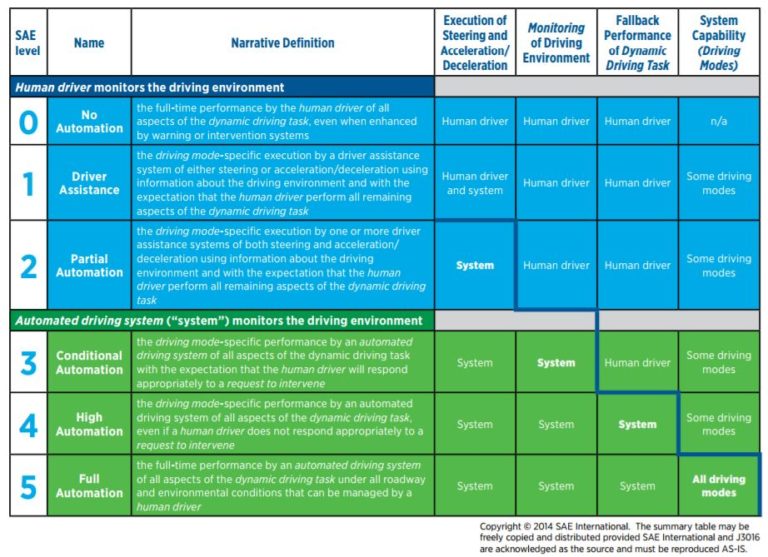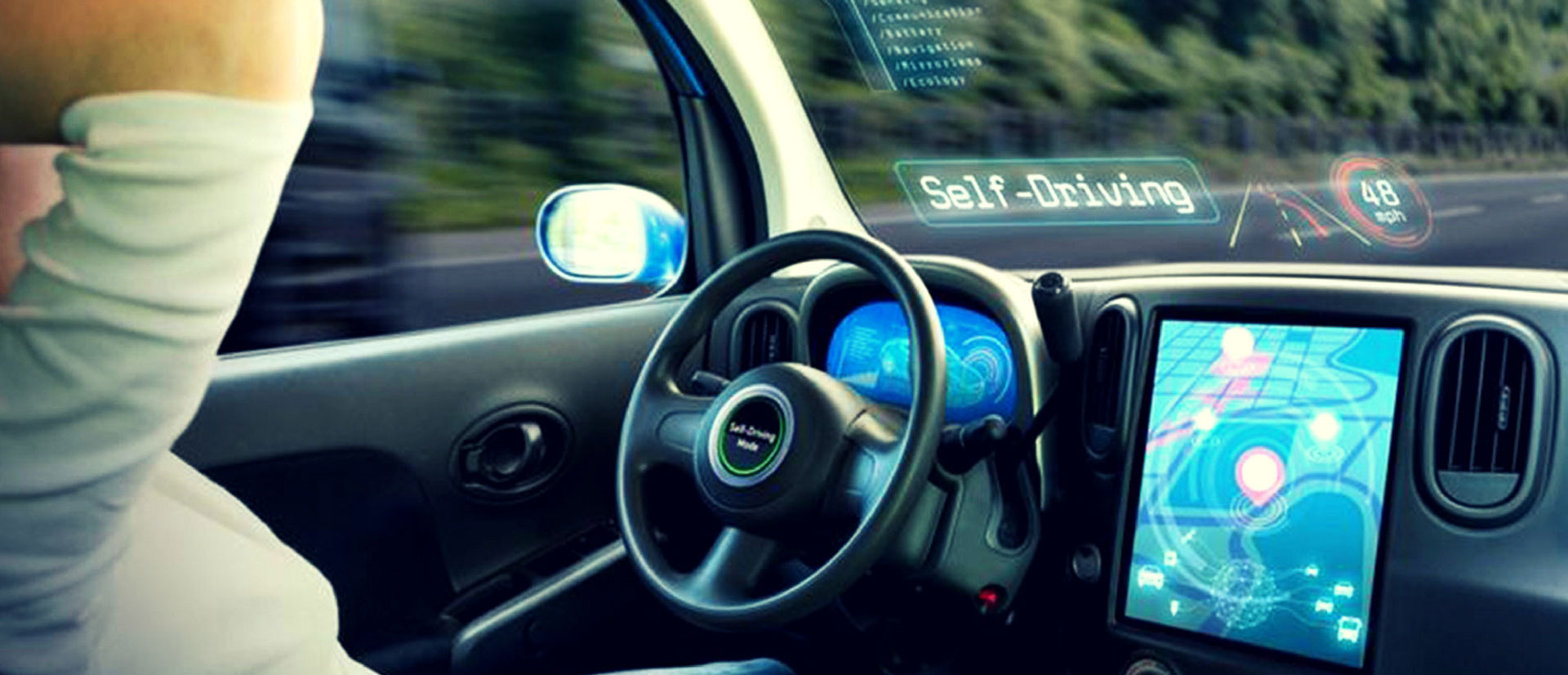It is logical to know where we are today about our driver-less car and what such cars mean to you, me and the industry.
Terms like autonomous, fully autonomous, driverless, self-driving, and self-piloting are often used arbitrarily by many of us to describe a car, without a proper understanding. Normally, car manufacturers do not mention about the level of automation, in their advertisements but talk more about the features offered. So the common man, not related to the car industry, cannot understand much.
It is imperative that there is clarity on these terms, then one would understand what is the capability of your car or what others claim about their car!
World standards adopted in 2016 -SAE/J3016 (Society of Automotive Engineers) Levels of automation.
Dynamic driving task- steering, braking, accelerating, monitoring the vehicle and roadway/responding to events, determining when to change lanes, turn, use signals, etc..
Driving mode -expressway merging, high-speed cruising, low-speed traffic jam, closed-campus operations, etc..
Levels 0 to Level 2: The driver monitors the driving environment
Level 0 No automation.
Human driver is in charge of everything and can travel on all motorable roads.
Level 1 and 2 Driver assistance systems can assist the driver in some driving modes only
Level 1: Driver Assistance
Driver assistance system assists the driver in execution (some driving modes) by doing a single task using either steering or acceleration/deceleration. Cruise control (acceleration) maintains the speed of the car that the driver asks for. But the driver has to take care of the turnings, staying in the lane, braking etc..
- Adaptive cruise control
2016 G, GLA, CLA-Class 2016 Honda Accord, Civic, CRV-3
Level 2: Partial Automation
One or more Driver assistance system assists the driver in execution (some driving modes) by doing tasks using both steering and acceleration/deceleration. Adaptive cruise control- the speed of the car (acceleration) is maintained, can slow down (deceleration) to avoid cars ahead and Lane keeping assist-can stick to its lane (steering, acceleration/deceleration). But when prompted by the ADS, the driver has to take over.
- Lane-centering steering and adaptive cruise control
2016 BMW 7 Series 2016 Mercedes-Benz C, E, CLS, S, GLE, GLS-Class 2017 Mercedes-Benz GLS-Class
Understanding some sensors that are used in cars.
- Radar- is a sensor system that uses radio waves to determine the velocity, range and angle of objects
- Cameras –An array of cameras with image sensors are to obtain 2D and 3D images of objects
- LIDAR System- Light Detection and Ranging and is a laser-based system used mainly to measure distances to stationary as well as moving objects. The system employs special procedures to provide three-dimensional images of the detected objects
- Ultrasonic Sensors- use sound navigation and radar to calculate the distance and/or direction of objects to enable vehicle parking as on 2018 commercially available cars are up-to Level 2 only!
- Car Infotainment Systems- with touch screen are also vital assists in car driving, irrespective of the automation Levels
Car infotainment systems, are Centre Information Display (CID) with Capacitive sensing touch screens that form the interface between the user (UI) and the systems like GPS Navigation Systems, touch screen and/or voice-activated audio and video systems, rear-view camera systems, lane change assist devices etc.
Car buyers have developed a craze and an inspiration from the use of touchscreen smartphones that allow smooth scrolling and easy accessibility to information. They expect the same level of comfort in touch screen car infotainment systems.
The driver is seated slightly away (at arm’s length) from the CID as compared to a person holding a smartphone. The driver’s attention is to be focused on the road always except during the momentary usage of the CID. This calls for a very reliable touch screen on the CID. Any distraction/ malfunction may lead to accidents and casualties.
More than the fast, bright, and responsive CID touch screen, automobile manufacturers have top priorities of adhering to the technical and safety standards of the CID.
This calls for precision testing of CID touch screens to ensure accuracy and reliability. To achieve this, modern touchscreen testing platforms utilize robotic arms.
Currently Level 3 to Level 5 cars are not commercially available. This clarifies upon some jargons misused to qualify a car!
Level 3 to Level 5: The Automated driving system monitors the driving environment.
Level 3. Conditional Automation
The automated driving system that can perform all the DDTs to drive the car for a certain part (some driving modes) of the journey and the driver takes over for the rest of the journey. The journey can be anywhere, on any motorable roads. When the ADS prompts the driver, for valid reasons, to take over then the rest of the responsibility lies with him.
These cars can assess the driving environment and take a decision as to when to change lanes, overtake other vehicles Audi’s prototype A7 can do that. They still need a human around if the weather messes with their sensors or the painted lane lines disappear, so no falling asleep at the wheel.
Expected arrivals of some Level 3 cars
New Audi A8 due by end of 2017(but delayed)
Driving for a single lane on the highway while under 35mph. It is based on their jack prototype and uses mobileye eyeq3 chip on a board called zFAS. Its latest sensors include 12 Ultrasonics, 8 Radars, 4 Top View Camera, 1 Wide View Front Camera and 2 Lidars (Forward & Rear)
Nissan in 2018
Driving for all driving situation on the highway.
Propilot 2.0 (multi-lane) Based on their Nissan Intelligent Driving platform, uses 5 Radars, 4 Lidars and 8 (12 now) surround cameras. It uses the mobileye eyeq4 chip including REM map of every highway in partnership with Zenrin.
Volvo in 2019
Based on their L4 Drive Me prototype using mobileye eyeQ4. Sensors include 7 radars, 7 cameras, 12 ultrasonics and 1 forward lidar.
Level 4. High Automation
The automated driving system that can perform all the DDTs and can drive the car for a whole journey. But the journey is within designated, mapped routes only (Some driving modes).The driver is present and even if he doesn’t respond to a prompt from the ADS, the ADS will take necessary action to bring the car to a safe halt.
GM Cruise AV-Arrived
Unveiled on 12th Jan 2018, the GM Cruise will enter as a commercial (robo- taxis) ride-sharing fleet in 2019.Approvals from several US federal governments are underway. The car has no steering wheel, no pedals and no manual controls. It is equipped with 21 radars, 16 cameras, and 5 Lidars and will operate in pre-mapped urban areas. However, the tests drives will include transporting people, food, and packages etc.The car has accommodations for visually and hearing impaired customers also.GM promises safety more than human driver-too early to call!
Google (Alphabet) WAYMO
Their prototypes have already clocked 3 lakh test miles till date in limited ride-sharing applications. No announcement of the launch has been made yet.
Level 5. Full Automation -Arrival may be decades later
The automated driving system that can perform all the DDTs and can drive the car for a whole journey without a driver. The journey can be anywhere, on any motorable road (All driving modes). No driver, no steering wheel, no pedals. The ADS performs all the duties as managed by a human driver under all driving and environmental conditions.
Prototypes arrival may be decades later. There is a buzz that Google has plans but no inputs are yet available.
Level 5 cars can be called fully autonomous or true driver-less cars No physical presence needed.
Impact on some business/aspects because of driverless cars :
Traffic would come down considerably depending on the mix of driver and driver-less cars with the development of a common communication protocol platform between driver-less cars and between the driver-less and human-driven cars.
Road fatalities, 90% which are due to human error, will reduce. This will reduce the ambulance services business and the emergency services business in hospitals.
Car collisions will go down leading to less business with car service centres for sheet metal.
Insurance premiums will go down but companies may work payout on the basis of the miles driven.
Role of traditional drivers would reduce but tech trained drivers will have their say.
Beverages and alcohol business would rise as such cars are a comfortable place to relax.
Detection of criminals by the police would be easier due to the cameras and validation data being stored centrally with the operator.
The advent of self-driving cars will give us comfort and cheer in many ways. Yet with hope we drive or are driving against hope. The safety criteria of driver-less cars are under intense and tough scrutiny. It is a long way to go before we repose our trust with technology than humans and welcome the self-driving car.
Get Automated
Applications of robotic automation are already in place in every industry. The time is “Now”! Get started right away with our customized product and service based solutions.
Embrace the future. Contact us to save your time and money to deliver a quality product.
Sources:
https://www.wired.com/
http://www.newelectronics.co.uk/electronics-technology/an-introduction-to-ultrasonic-sensors-for-vehicle-parking/24966/
http://www.wired.co.uk/article/autonomous-car-levels-sae-ranking
https://venturebeat.com/2017/06/04/self-driving-car-timeline-for-11-top-automakers/



Jalia
February 8, 2018A bit superisrd it seems to simple and yet useful.